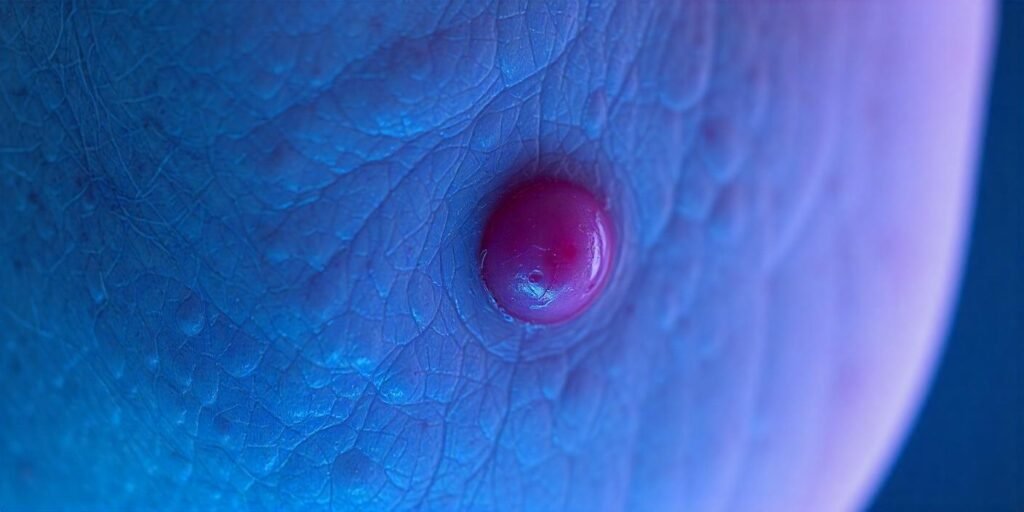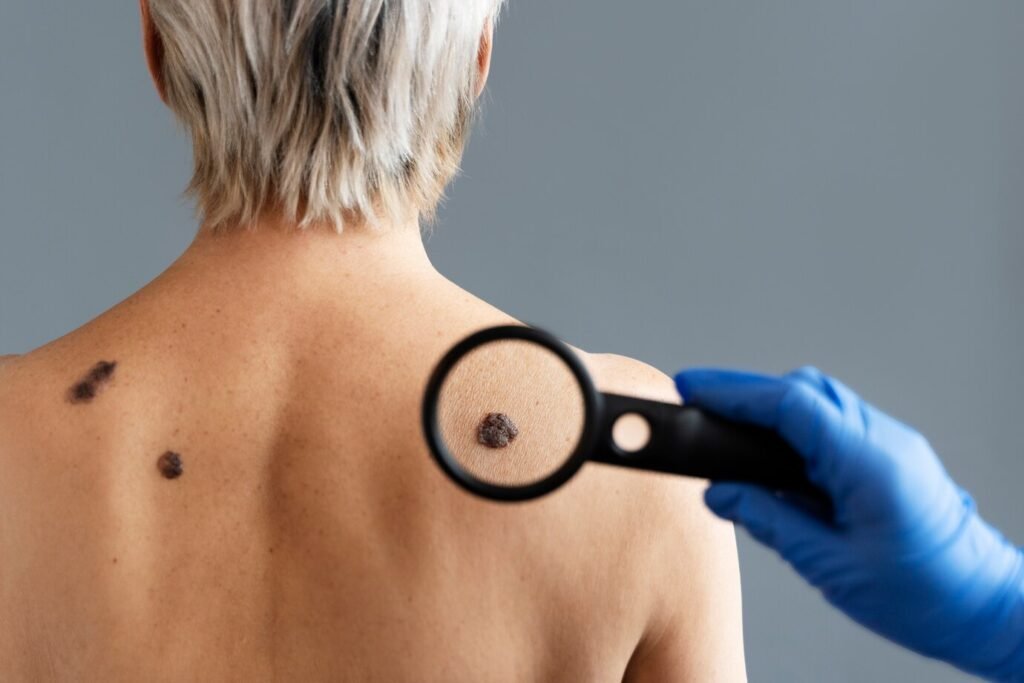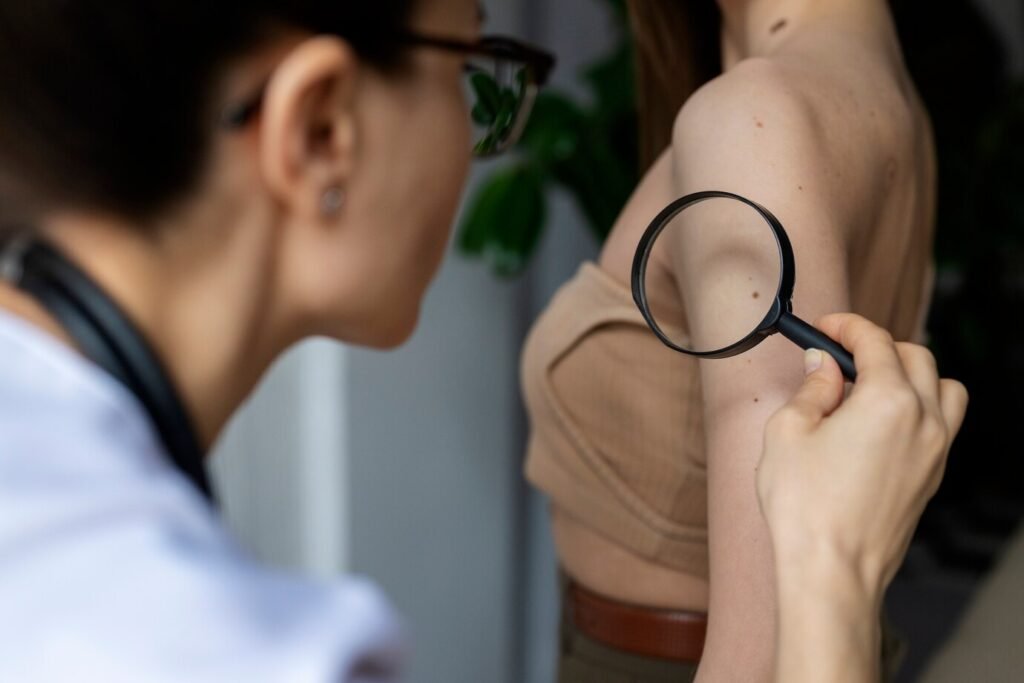Introduction
This article covers the skin cancer symptoms. Skin cancer is one of the most prevalent forms of cancer worldwide, affecting millions of individuals each year. With early detection being crucial for effective treatment, understanding the skin cancer symptoms is essential. This guide aims to provide you with a thorough understanding of skin cancer symptoms, empowering you with the knowledge to recognize potential warning skin cancer symptoms. By the end of this article, you will not only be informed but also equipped to take proactive steps in monitoring your skin health.

Table of Contents
What is Skin Cancer?
Skin cancer occurs when skin cells begin to grow uncontrollably. This abnormal growth can lead to tumors, which may be benign (non-cancerous) or malignant (cancerous). The three most common types of skin cancer are basal cell carcinoma, squamous cell carcinoma, and melanoma. Each type has distinct characteristics and skin cancer symptoms, making it vital to understand what to look for.
Types of Skin Cancer
- Basal Cell Carcinoma (BCC): This cancer is recognized as the most prevalent type of skin cancer. BCC often manifests as a small, shiny bump that may catch the light or as a flat, pink lesion that might be mistaken for a harmless skin imperfection. Typically, it appears in areas of the skin that are frequently exposed to sunlight, including common locations such as the face, ears, and neck. While basal cell carcinoma rarely metastasizes or spreads to distant organs, it can invade nearby tissues and cause significant local destruction if left untreated, making awareness and early detection crucial for effective management.

- Squamous Cell Carcinoma (SCC): Squamous Cell Carcinoma can present itself in various forms, often showing up as a firm, red nodule that can feel raised or a flat lesion with a scaly texture. This type of skin cancer can also arise in regions of the skin that have significant sun exposure, similar to BCC. However, SCC is known to be more aggressive than basal cell carcinoma, meaning it has a higher potential to spread to other parts of the body if not addressed in a timely manner. Recognizing the skin cancer symptoms of SCC, such as changes in the texture or appearance of your skin, is important for early intervention and successful treatment.

- Melanoma: Considered the most perilous type of skin cancer, melanoma poses a serious health risk and can emerge from pre-existing moles or present as entirely new and unusual growths on the skin. It is frequently identifiable by its dark color and irregular, asymmetrical shape, often contrasting sharply with surrounding skin. Melanoma may also exhibit variation in color, with shades of black, brown, and sometimes even red or blue. Due to its aggressive nature, early detection and intervention are crucial for improving outcomes, so individuals are encouraged to monitor their skin for any changes and consult a healthcare professional if they notice any concerning developments.

Recognizing Skin Cancer Symptoms
Early detection of skin cancer significantly increases the chances of successful treatment. Here are some common skin cancer symptoms to watch for:
Changes in Moles
One of the most critical skin cancer symptoms is a change in existing moles. Monitor your moles for the following characteristics using the ABCDE rule:
- Asymmetry: One half of the mole does not match the other.
- Border: The edges are irregular, ragged, or blurred.
- Color: The color is uneven, with shades of brown, black, or tan.
- Diameter: The mole is larger than 6 mm (about the size of a pencil eraser).
- Evolving: The mole changes in size, shape, or color over time.
New Growths
It is important to regularly monitor your skin for any new growths that may emerge, particularly if they appear unexpectedly and without warning. These growths can come in different shapes, such as being either flat against the skin or raised above the surface. Additionally, it is worth noting that they can exhibit a wide range of colors, which may differ from your natural skin tone. Being vigilant about any changes in your skin can help ensure timely attention to potential issues.
Itching or Tenderness
If a mole or spot on your skin starts to feel itchy, becomes tender to the touch, or develops pain, this could potentially indicate the presence of skin cancer. While itching by itself is not a definitive symptom of skin cancer, it is important to recognize that it can be a warning skin cancer symptoms. This symptom should not be dismissed or overlooked, particularly if it occurs in conjunction with other noticeable changes in the appearance of the mole or spot, such as alterations in color, size, or shape. Being vigilant and aware of such changes is essential for early detection and treatment.

Non-Healing Sores
Sores that persist and do not show skin cancer symptoms of healing after a few weeks’ time should definitely be evaluated by a qualified healthcare professional. The failure of these sores to heal properly can be a signal of potential underlying issues, which may include conditions such as basal cell carcinoma or squamous cell carcinoma. It is important to seek medical advice promptly to rule out any serious concerns related to skin health.
Scaly Patches
Red, scaly patches on the skin that may bleed or develop a crusty appearance can be indicators of squamous cell carcinoma, a type of skin cancer. These concerning patches typically form on areas of the skin that have been exposed to sunlight. Often, these lesions are misidentified as common skin conditions such as eczema or psoriasis, leading to potential delays in diagnosis. It’s important to be vigilant about changes in your skin, especially if you notice such patches appearing in areas that receive frequent sun exposure, as early detection can be crucial for effective treatment.
Risk Factors for Skin Cancer
Understanding the risk factors associated with skin cancer can help you take preventive measures. Some common risk factors include:
- Excessive Sun Exposure: Prolonged exposure to ultraviolet (UV) radiation, whether from the natural sunlight or from artificial sources like tanning beds, significantly increases the risk of developing skin cancer. This is because UV radiation can cause damage to the DNA in skin cells, leading to mutations that may result in cancer over time. It is essential to be aware of the dangers associated with excessive sun exposure and to take appropriate protective measures, such as using sunscreen, wearing protective clothing, and seeking shade during peak sunlight hours.
- Fair Skin: Individuals who possess fair skin, along with light-colored hair and light-colored eyes, face a heightened risk of skin cancer. This increased vulnerability is primarily due to their lower levels of melanin, a pigment that offers some degree of protection against the harmful effects of UV radiation. As a result, those with fair skin are advised to be particularly cautious when spending time outdoors, as they may burn more easily and sustain greater skin damage from UV exposure.
- Family History: Having a family history of skin cancer can significantly elevate your risk of developing the disease yourself. This correlation suggests a genetic predisposition that may make certain individuals more susceptible to the effects of UV radiation and other risk factors associated with skin cancer. It is important for individuals with a family history of skin cancer to be vigilant about regular skin checks and to discuss their risk factors with a healthcare professional.
- Age: The likelihood of developing skin cancer tends to increase as individuals grow older. This increased risk is largely attributed to the accumulation of damage to skin cells over the years, as repeated exposure to UV radiation can lead to long-term changes in the skin. As a person ages, their skin may also become thinner and less resilient, further contributing to the risk of skin cancer. Therefore, it is crucial for older adults to be proactive about skin health and monitoring for any changes.
- Immune Suppression: Individuals who have weakened immune systems, such as those who have undergone organ transplants or are living with conditions that compromise immune function, are at a greater risk of developing skin cancer. A weakened immune system may be less effective at repairing damaged skin cells and fighting off cancerous changes. For this reason, it is vital for immunocompromised individuals to take extra precautions to protect their skin from UV exposure and to have regular check-ups with a dermatologist to monitor for any skin cancer symptoms.

Prevention Tips
While not all skin cancers can be prevented, there are several steps you can take to reduce your risk:
- Make Sure to Use Sunscreen: It is essential to apply a broad-spectrum sunscreen that has an SPF of at least 30 on a daily basis, regardless of whether it is sunny or cloudy outside. Ultraviolet rays can penetrate the clouds and still affect your skin. To maintain effective protection, remember to reapply your sunscreen every two hours, and make sure to do so particularly after activities like swimming or sweating, as these can diminish the effectiveness of the sunscreen.
- Opt for Protective Clothing: When selecting clothing for outdoor activities, it’s a good idea to choose long-sleeved shirts that cover your arms, and wide-brimmed hats to provide ample coverage for your face, ears, and neck, which are often vulnerable to sunlight. Additionally, wearing sunglasses that block both UVA and UVB rays is important to protect your eyes and the delicate skin around them from harmful UV radiation.
- Seek Shade: It is wise to limit your exposure to direct sunlight during the peak hours of the day, particularly between 10 a.m. and 4 p.m. This is when UV radiation is at its strongest, and the sun’s rays can be especially damaging to your skin. Finding shaded areas or utilizing umbrellas and canopies can help you stay protected during these high-risk hours.
- Stay Away from Tanning Beds: It is important to avoid tanning beds altogether because they emit harmful ultraviolet radiation, which significantly increases the risk of developing skin cancer over time. Natural sunlight, as well as artificial UV devices, can lead to premature skin aging and other skin-related issues. Prioritizing your skin’s health means steering clear of these harmful practices.
- Conduct Regular Skin Checks: To ensure the ongoing health of your skin, perform monthly self-examinations to check for any unusual moles, spots, or changes in your skin. In addition to your personal assessments, it is crucial to schedule annual check-ups with a qualified dermatologist who can provide a professional evaluation of your skin’s condition and detect any potential issues early on.

When to See a Doctor
If you notice any of the skin cancer symptoms mentioned above or have concerns about your skin, it is crucial to consult a healthcare professional. Early diagnosis and treatment can significantly improve outcomes.
Conclusion
Understanding the skin cancer symptoms are vital for early detection and treatment. By being proactive about your skin health and recognizing the warning skin cancer symptoms, you can take control of your well-being. Remember to perform regular self-examinations, protect your skin from UV exposure, and consult a healthcare professional when necessary. Your health is your greatest asset—take the necessary steps to safeguard it.
Frequently Asked Questions (FAQs)
1. What are the most common skin cancer symptoms?
The most common skin cancer symptoms include changes in moles, new growths, itching or tenderness, non-healing sores, and scaly patches.
2. How can I perform a self-examination for skin cancer?
To perform a self-examination, look for any changes in the size, shape, or color of your moles. Use the ABCDE rule to evaluate existing moles and check your entire body for new growths.
3. What should I do if I notice a suspicious mole?
If you notice a mole that fits the ABCDE criteria or any other unusual skin changes, schedule an appointment with a dermatologist as soon as possible.
4. Can skin cancer be prevented?
While not all skin cancers are preventable, you can reduce your risk by using sunscreen, wearing protective clothing, seeking shade, and avoiding tanning beds.
5. How often should I see a dermatologist for skin checks?
It is recommended to have an annual skin check with a dermatologist, but individuals at higher risk may need more frequent evaluations.
By understanding skin cancer symptoms and adopting preventive measures, you can take charge of your skin health and reduce your risk of developing this serious condition. Stay informed, stay protected, and prioritize your well-being.



